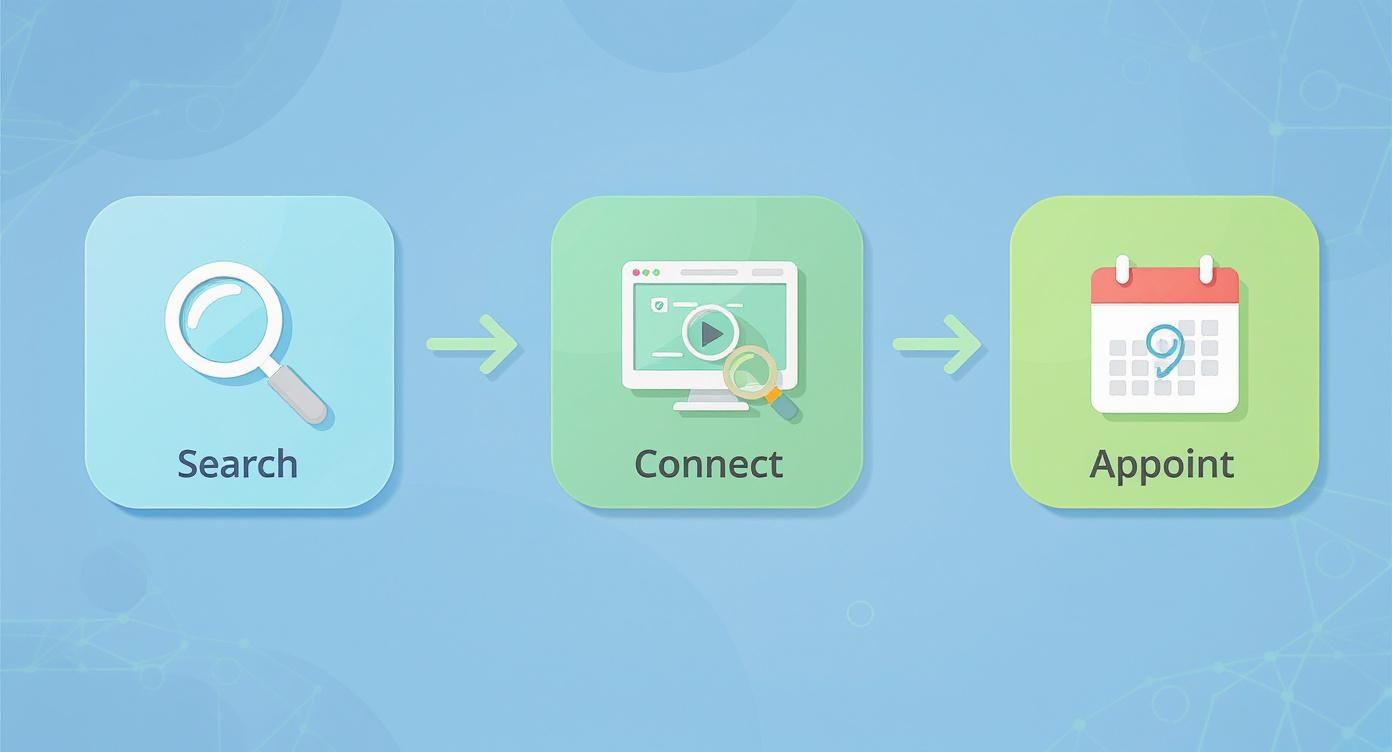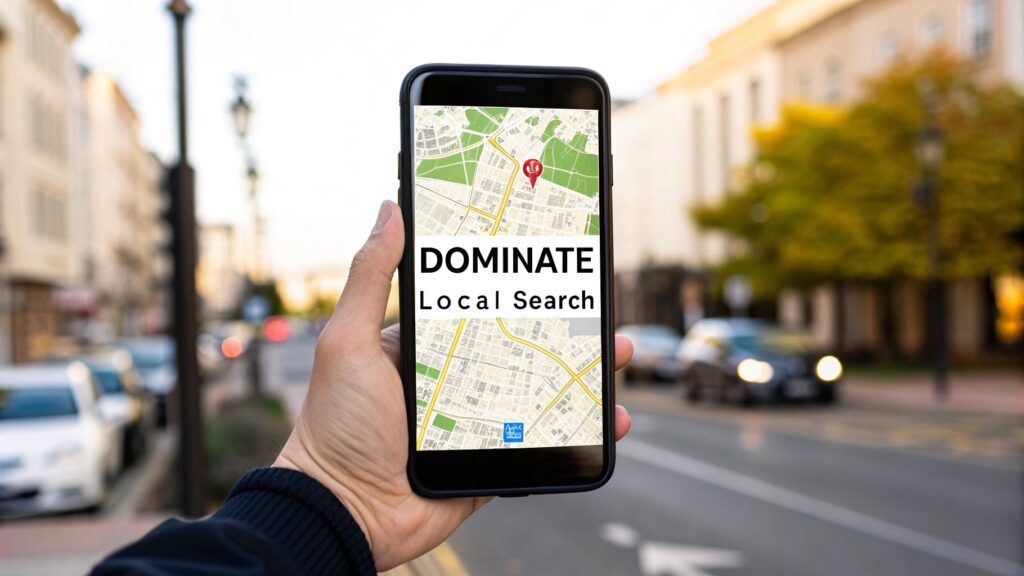Think of ophthalmology SEO as the science of getting your eye care practice to the top of Google. When someone in your area searches for LASIK, cataract surgery, or an eye exam, you want to be the first name they see. It's the most effective way to get a steady stream of new patients.
In Short: Ophthalmology SEO helps patients find your practice online when they search for eye care services.
Why SEO is the New Patient Referral
The days of relying only on patient referrals are over. Today, finding a new ophthalmologist starts with a Google search. Your next patient is likely searching "best LASIK surgeon near me" or "symptoms of cataracts" right now.
This is where a smart ophthalmology SEO strategy is essential. It's the modern version of word-of-mouth, but with a much wider and more predictable reach.
The Modern Patient's Journey
From the first worry to booking an appointment, patients follow a clear digital path. SEO helps you show up at every important step.

If you're not visible in search results, you're invisible to most potential patients. A solid SEO foundation ensures your practice is the answer they find.
The results are clear. A strong online presence leads to more phone calls and booked appointments. I've seen a single practice get over 1,200 new patients in just one month from their SEO efforts alone.
What is ophthalmology SEO?
Ophthalmology SEO is a set of strategies to make your website more appealing to search engines like Google. It helps Google understand who you are, what you do, where you are, and why you’re the best choice for patients.
Think of it as having four main parts:
- Local SEO: This helps you show up for "near me" searches and in the Google Maps results.
- On-Page SEO: This involves optimizing your service pages, titles, and website content with the right keywords.
- Content Marketing: You become a trusted source by creating helpful blog posts that answer patient questions.
- Technical SEO: This is the behind-the-scenes work to make sure your site is fast, mobile-friendly, and easy for Google to crawl.
Key Takeaway: SEO isn't just about being found—it's about being chosen. Ranking high on Google instantly builds trust and positions you as a leading authority before a patient even clicks.
How Can SEO Grow an Ophthalmology Practice?
A good SEO strategy brings the right people to your website—people actively looking for high-value procedures. This is a critical part of any modern doctor marketing plan.
Here’s what it can do for you:
- Attract High-Intent Patients: Connect with people searching for specific treatments like retinal detachment repair or glaucoma care.
- Reduce Ad Spend: High organic rankings bring in consistent, "free" traffic, lowering your cost to acquire new patients.
- Build Your Brand: Ranking for complex medical topics establishes your reputation as the local expert.
- See a Clear ROI: Unlike a billboard, you can track exactly how many calls and appointments your SEO generates.
Winning the Local Search Game

For an ophthalmology practice, local search is everything. Your best patients are nearby. When they need care, they search Google for "eye specialist near me" or "glaucoma doctor in Dallas."
This is where local SEO makes a huge difference. Showing up in these searches, especially in the Google "map pack," is the best way to get patients who are ready to book. It all starts with your Google Business Profile (GBP).
Your Google Business Profile is Your Digital Front Door
Think of your GBP listing as your clinic's online entrance. It’s often the first impression a potential patient has of your practice.
A half-finished profile isn't enough. To turn your GBP into a patient-attracting tool, you need to fill out every single section completely and accurately.
In Short: Your Google Business Profile is a live snapshot of your practice. A well-managed profile signals to Google that you're an active, reputable provider, which boosts your local search rankings.
How to Optimize Your GBP for Maximum Impact
Setting up your profile is step one. Optimizing it shows patients why you're their best choice.
Here’s what to focus on:
- Choose the Right Categories: Be specific. Your main category is "Ophthalmologist," but add secondary ones like "Eye Care Center," "LASIK Surgeon," or "Cataract Surgeon" if they apply. This helps Google match you with more specific searches.
- Showcase Your Services: List every procedure you offer, such as LASIK, cataract surgery, and glaucoma treatment. Use simple language that patients understand.
- Upload High-Quality Photos and Videos: Show off your practice. Post clear photos of your office, your team, and your equipment. Videos of doctors explaining procedures can build a lot of trust.
- Turn On Messaging and Q&A: Make it easy for patients to contact you. Answering questions in the Q&A section shows you're engaged and helpful.
Understanding the patient's mindset is key. To learn more, see this guide on how to find the best local eye doctor and apply those insights to your profile.
The Power of Patient Reviews and Consistent Info
Reviews are the new word-of-mouth. Encouraging happy patients to leave a review on your GBP can seriously improve your visibility.
Equally important is NAP consistency. This stands for Name, Address, and Phone number. Google wants to see the exact same information for your practice everywhere online—on your website, GBP, Yelp, etc. Any difference can hurt your local rankings.
Local SEO Priority Checklist for Ophthalmologists
| Local SEO Task | Priority Level | Key Action |
|---|---|---|
| Google Business Profile Optimization | High | Fill out every section, add photos weekly, and encourage reviews. |
| NAP Consistency | High | Audit and correct your business info across all major online directories. |
| Patient Reviews | High | Implement a system to consistently request reviews from happy patients. |
| Location-Specific Website Pages | Medium | Create unique pages on your site for each office location and core service. |
| Local Link Building | Medium | Get listed on local health directories and community websites. |
| On-Page SEO (Local Keywords) | Medium | Weave location-based keywords into your website's titles and content. |
Focusing on these high-priority items first will help you climb in local search results.
What are good examples of ophthalmology services to list on Google Business Profile?
When adding services, think like a patient, not a doctor. Avoid technical jargon.
- Comprehensive Eye Exams
- Cataract Surgery & Lens Implants
- LASIK & Refractive Surgery Consultation
- Glaucoma Diagnosis & Treatment
- Retina and Macular Degeneration Care
- Diabetic Eye Care
- Pediatric Eye Exams
Going Hyper-Local with Location-Specific Pages
If you have multiple clinics, create dedicated pages on your website for each city you serve. These pages are built to rank for searches like "cataract surgery in Houston."
Each page needs to be unique and useful.
Include details specific to that office:
- Unique Content: Talk about the services offered at that location.
- Local Information: Mention nearby landmarks or parking tips.
- Local Team: Feature photos and bios of the doctors and staff.
- Local Testimonials: Use reviews from patients who visited that office.
This hyper-local focus tells Google you are the authority for eye care in that specific area. For a deeper dive into these techniques, check out this complete guide on Local Maps SEO.
Finding Keywords Patients Actually Use

Keyword research is about understanding what patients type into Google. What are their exact phrases when they're worried about blurry vision or considering LASIK?
Great ophthalmology SEO starts here. It's about speaking the same language as the people you want to help. This helps you create content that connects with them.
Three Types of Patient Searches
Patient searches usually fall into one of three categories. Understanding them helps you meet people at every stage of their journey.
- Informational Searches: These are question-based. Think "early signs of glaucoma" or "what does LASIK recovery feel like?" The person is looking for a trustworthy expert.
- Local Searches: This is where your practice can win. Searches like "eye doctor near me" or "ophthalmologist in Austin" show someone needs local services soon.
- High-Intent Searches: These searches are ready to convert. When someone looks up "best cataract surgeon in Miami," they are past the research phase and ready to book.
By targeting a mix of all three, you become the go-to resource from the first question to the final appointment.
How to Find Your Practice's Best Keywords
You don’t need a big budget to start. Some of the best tools are free.
Start with Google. Type in a service you offer. Look at the "People Also Ask" box and the "Related searches" at the bottom of the page. These are gold mines of what real people are searching for.
For example, a search for "cataract surgery" might show questions like, "What is the average age for cataract surgery?" or "How long is the recovery from cataract surgery?" These are perfect topics for your next blog post.
Leveling Up With Professional Tools
While free methods are great, professional SEO tools like Ahrefs or SEMrush offer deeper insights. They show you:
- Search Volume: How many people search for a keyword each month.
- Keyword Difficulty: How hard it will be to rank on page one.
- Related Keywords: A huge list of variations and questions.
What are the best long-tail keywords for an ophthalmology practice?
Long-tail keywords are longer, more specific phrases. They have less search traffic, but the people using them are often ready to make a decision.
Think about how patients talk.
- They search for "advanced LASIK for astigmatism," not just "LASIK."
- They search for a "pediatric ophthalmologist for lazy eye," not just a "kids eye doctor."
- They search for "multifocal lens implants after cataract surgery," not just "cataract lenses."
Focusing on these specific phrases helps you attract patients who know what they need and are ready to schedule a procedure.
Creating Website Content That Builds Patient Trust

In healthcare, your website content must build trust. It needs to be a calm, reassuring, and authoritative voice for anxious patients.
This is where Google’s concept of E-A-T (Expertise, Authoritativeness, and Trustworthiness) is not just an SEO tactic—it's good patient care.
In Short: Write content that is expert-driven, authoritative, and trustworthy to build confidence with potential patients.
Building Trust with E-A-T
E-A-T is Google’s way of rewarding content that genuinely helps people, especially in medicine. Your content must be accurate, transparent, and written (or reviewed) by a medical expert.
Here's how to apply E-A-T:
- Showcase Expertise: Attribute every clinical article to one of your ophthalmologists. Include their bio, photo, and credentials.
- Build Authority: Feature any publications, conference talks, or media mentions your doctors have. This proves they are leaders in the field.
- Earn Trustworthiness: Make your contact info, privacy policy, and patient reviews easy to find. Transparency is key.
Designing Service Pages That Convert
Your pages for LASIK, glaucoma, or retinal repair are like digital consultation rooms. They must answer every question a nervous patient might have.
A great service page walks the patient from understanding their symptoms to envisioning a successful recovery. Over 80% of patients start their search online, making your website a critical first impression. You can learn more about this patient journey and ophthalmology SEO at comradeweb.com.
Your service pages should be the ultimate resource—answering questions, calming fears, and showing a clear path forward.
Turning Your Blog into a Patient Education Hub
A blog is one of the most powerful ophthalmology SEO tools. It lets you connect with people on a human level and target question-based keywords.
The best blog posts come from the questions you hear in the exam room every day.
Key Takeaway: Your blog is where you answer the questions patients are too nervous to ask. Addressing fears about pain, recovery, or cost builds incredible trust before they even call.
What should an ophthalmology blog talk about?
The best topics provide immediate value and peace of mind.
- Address Patient Fears: A post like, "Is LASIK Painful? What to Really Expect," speaks directly to a major concern.
- Explain Your Technology: Have new equipment? Write a post explaining how it works and how it improves care.
- Introduce Your Team: A "Meet the Doctor" Q&A series helps humanize your practice and makes patients feel more comfortable.
Getting Your Website's Tech and User Experience Right
You can have the best content, but if your site is hard to use, it's all for nothing. The technical side of SEO ensures both search engines and patients have a smooth experience.
Think of it like a house foundation. A technically solid website is the foundation for your entire online presence.
Making a Great First Impression in Search Results
A patient's first interaction with you is your title tag and meta description in Google search results. These are your one shot to convince someone to click your link.
A title like "LASIK – Our Clinic" is forgettable.
A stronger version is "Advanced LASIK in [Your City] | Experienced Surgeons | [Practice Name]". It’s specific, local, and builds trust.
Guiding People (and Google) Through Your Site
Once they click, your page structure is key. Use headings correctly—one main H1 title per page, with H2s and H3s for sub-sections. This breaks down complex medical information into easy-to-scan chunks.
This clear structure is also a roadmap for search engines, helping them understand your content and rank you for the right searches.
In Short: A well-structured page respects the reader's time. By making information easy to find, you build subconscious trust with potential patients.
Internal links are also important. When you write a blog post about glaucoma symptoms, link to your main "Glaucoma Treatment" service page. This creates a logical path for users and spreads SEO authority across your site.
Why Your Website's Health is a Dealbreaker
Two of the biggest technical factors are page speed and mobile-friendliness. A slow-loading website is a practice killer. If your page takes more than a few seconds to load, potential patients will leave.
The majority of your patients find you on their phones. If they have to pinch and zoom to read something, you've lost them.
- Page Speed: Use a tool like Google PageSpeed Insights to check your site. Large image files are a common culprit.
- Mobile-Friendliness: Your website must have a responsive design that looks great on any screen, from a desktop to a smartphone.
A great site is intuitive. This focus on the user's journey is similar to applying the principles of user interface design and usability. A seamless experience signals professionalism and care.
Common Questions About Ophthalmology SEO
Here are answers to some of the most common questions about ophthalmology SEO.
1. How long does it take to see results from SEO?
It depends. SEO is like planting a garden; it takes time.
You can often see early movement in 3 to 6 months. This might be better rankings in the local map pack or for less competitive keywords.
For competitive terms like "LASIK surgeon" in a big city, it can take 6 to 12 months. SEO is a long-term investment in your practice's visibility.
In Short: SEO is like building a great reputation. The work you do today—optimizing your site and writing helpful content—builds on itself over time to create a reliable stream of new patients.
2. Is SEO a good investment for ophthalmologists?
Yes, SEO is one of the best long-term investments for an ophthalmology practice. Unlike paid ads, where you pay for every click, a high organic ranking generates a steady stream of "free" traffic from patients actively seeking your services. This leads to a lower patient acquisition cost and a higher return on investment over time. A well-executed ophthalmology SEO strategy builds a valuable digital asset that continuously attracts high-value patients for years.
3. Can I do SEO myself?
Yes, you can definitely start yourself. A motivated practice manager can handle foundational tasks.
Here are a few things you can manage in-house:
- Your Google Business Profile: Keep it updated with fresh photos and respond to every review.
- Simple Content Creation: Turn common patient questions into blog posts.
- Basic On-Page SEO: Make sure your service page titles are clear and speak directly to a patient's problem.
However, deeper ophthalmology SEO tasks like technical audits and building high-authority links often require a specialist. Many practices use a hybrid approach: they manage daily content and partner with a pro for heavy lifting.
4. Is it better to pay for Google Ads or do SEO?
They work best together.
- Google Ads (PPC): This is like a faucet. You pay, and you get immediate visibility. It’s perfect for getting leads right now.
- SEO: This is like digging a well. It’s more work upfront, but it provides a sustainable flow of "free" organic traffic and builds long-term trust.
The smartest marketing plans use both. You might run a Google Ad for "emergency eye exams" while your SEO strategy works on ranking you for "best cataract surgeon" over the long term.
At Clicks Geek, we build digital marketing strategies that bring real, measurable growth to practices just like yours. If you want to turn your website into a machine for attracting new patients, we're here to help. Find out more about our proven marketing services.
Is Your Business Ranking in Google Maps?
Turn Google Maps into a Lead Engine w/ Clicks Geek’s AI-powered local SEO. 3,000+ clients served. Our proprietary, fully done-for-you Maps SEO system handles everything—keyword targeting, local optimization, content, reviews, and ranking strategy—automatically.






